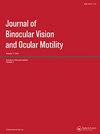急性获得性合并内斜视的兴起
Q3 Medicine
Journal of Binocular Vision and Ocular Motility
Pub Date : 2023-06-29
DOI:10.1080/2576117X.2023.2226675
引用次数: 0
摘要
急性获得性合并内斜视(AACE)是一种不常见的内斜视亚型,表现为晚期突然出现相对较大的合并内斜角,伴有复视和相对较小的屈光不正,在儿童中常见的是远视,在成人中常见的是近视,在年龄较大的儿童和成人中双眼最佳矫正视力正常。1-6 AACE 的病理和非病理原因均有记录。1,本文章由计算机程序翻译,如有差异,请以英文原文为准。
The Rise of Acute Acquired Comitant Esotropia
Acute acquired comitant esotropia (AACE) is an uncommon subtype of esotropia recognized by sudden late onset of a relatively large angle of comitant esotropia with diplopia and comparatively minimal refractive error, commonly hypermetropia in children and myopia in adults, along with normal best-corrected visual acuity in both eyes in older children and adults. 1–6 Pathological and non-pathological causes have been recorded for AACE. 1,
求助全文
通过发布文献求助,成功后即可免费获取论文全文。
去求助
来源期刊

Journal of Binocular Vision and Ocular Motility
Medicine-Ophthalmology
CiteScore
1.20
自引率
0.00%
发文量
42
 求助内容:
求助内容: 应助结果提醒方式:
应助结果提醒方式:


